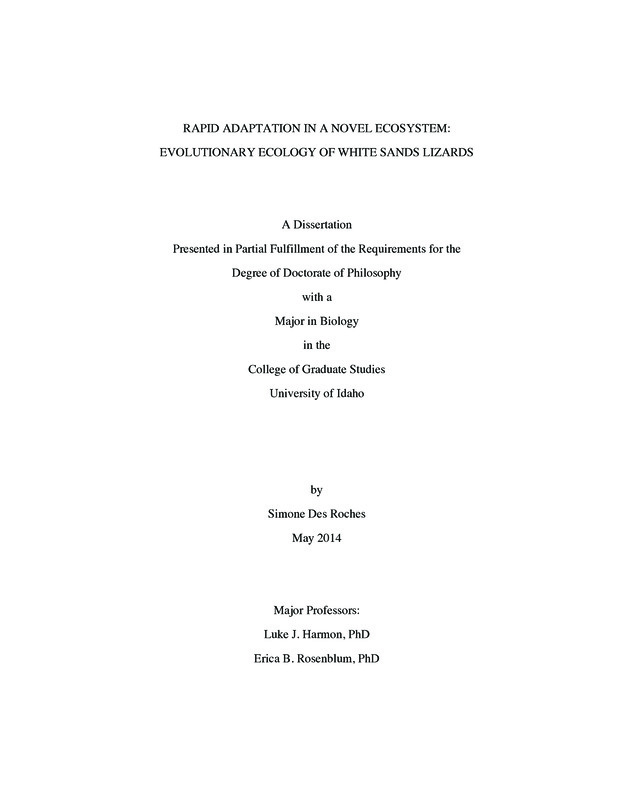RAPID ADAPTATION IN A NOVEL ECOSYSTEM: EVOLUTIONARY ECOLOGY OF WHITE SANDS LIZARDS
Des Roches, Simone. (2014). RAPID ADAPTATION IN A NOVEL ECOSYSTEM: EVOLUTIONARY ECOLOGY OF WHITE SANDS LIZARDS. Theses and Dissertations Collection, University of Idaho Library Digital Collections. https://www.lib.uidaho.edu/digital/etd/items/desroches_idaho_0089e_10276.html
- Title:
- RAPID ADAPTATION IN A NOVEL ECOSYSTEM: EVOLUTIONARY ECOLOGY OF WHITE SANDS LIZARDS
- Author:
- Des Roches, Simone
- Date:
- 2014
- Keywords:
- Adaptation Ecological Release Ecomorphology Evolution Herpetology Natural Selection
- Program:
- Biology
- Subject Category:
- Ecology
- Abstract:
-
The species of lizards that inhabit White Sands, New Mexico provide an ideal system in which to study evolutionary and ecological interactions. Characterized by 250 square miles of gypsum sand dunes, White Sands formed in the last two to seven thousand years. Three lizard species, the Lesser Earless Lizard (
Holbrookia maculata ), the Southwestern Fence Lizard (Sceloporus cowlesi ), and the Little Striped Whiptail (Aspidoscelis inornata ) colonized White Sands since its formation and today exhibit blanched colouration, unlike their closely related dark-coloured counterparts inhabiting the surrounding Chihuahuan Desert. As both a geologically young and novel ecosystem, White Sands provides a setting for studying ecological and evolutionary changes in its colonist species.In my dissertation, I examined the ecological implications of morphological differences between White Sands and dark soils lizards and investigated the current dynamics of ecological population dynamics and natural selection on White Sands lizard populations. In Chapter I, I introduced the geological history of White Sands and the biological history of its lizard inhabitants. In Chapter II, I examined whether White Sand lizards show evidence of ecological release. Specifically, I found that there are fewer potential competitor and predator species in White Sands and the three resident species exhibit density compensation. Furthermore, one of the White Sands species,
S. cowlesi , demonstrates expansion of resource use by using a greater variety of perch types than in dark soils habitats. In chapters III and IV, I explored whether ecologically relevant morphology, performance, and resource use showed evidence of ecological release and directional selection. In particular, I found that two species White Sands lizards have longer legs than their dark soils counterparts, but this does not influence their sprint speed as much as their behavioural response to a simulated predator. In addition, all three species consume a greater number of prey species in White Sands than in dark soils; however, onlyA. inornata eats significantly harder prey, and onlyH. maculata has expanded the variability of its diet in White Sands. Finally, in Chapter V, I investigated the changes in population demographics and selection on ecologically important traits in two species,S. cowlesi andH. maculata on the White Sands ecotone over two to three years. I found extreme differences in the ratio of juveniles to adults, growth, dispersal distances, and potential selection on traits between the two species over time. - Description:
- doctoral, Ph.D., Biology -- University of Idaho - College of Graduate Studies, 2014
- Major Professor:
- Harmon, Luke J; Rosenblum, Erica B
- Committee:
- Parent, Christine; Schluter, Dolph
- Defense Date:
- 2014
- Identifier:
- DesRoches_idaho_0089E_10276
- Type:
- Text
- Format Original:
- Format:
- application/pdf
- Rights:
- In Copyright - Educational Use Permitted. For more information, please contact University of Idaho Library Special Collections and Archives Department at libspec@uidaho.edu.
- Standardized Rights:
- http://rightsstatements.org/vocab/InC-EDU/1.0/

